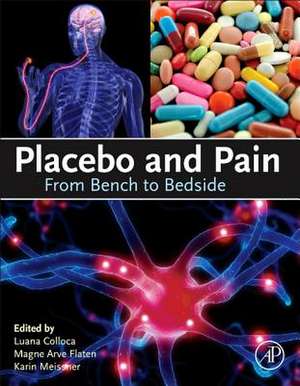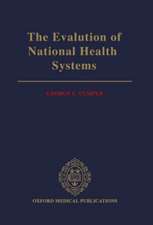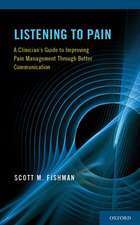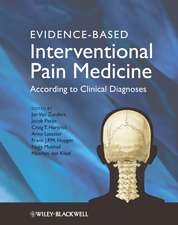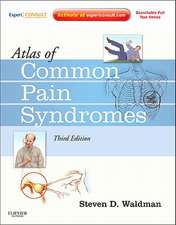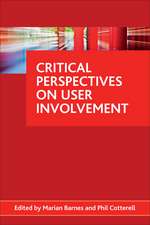Placebo and Pain: From Bench to Bedside
Editat de Luana Colloca, Magne Arve Flaten, Karin Meissneren Limba Engleză Hardback – 12 noi 2013
Review for Placebo and Pain:“This ambitious book is the first comprehensive and unified presentation of the placebo and nocebo phenomena in the area of pain. Written by the international leading experts in the field, the book provides an accurate up-to-date [work] on placebo and pain dealing with current perspectives and future challenging issues.--Ted Kaptchuk, Associate Professor of Medicine, Harvard Medical School
- Contains historical aspects of the placebo effect
- Discusses biological and psychological mechanisms of placebo analgesic responses
- Reviews implications of the placebo effect for clinical research and pain management
- Includes methodological and ethical aspects of the placebo effect
Preț: 468.16 lei
Preț vechi: 575.78 lei
-19% Nou
Puncte Express: 702
Preț estimativ în valută:
89.58€ • 93.53$ • 74.14£
89.58€ • 93.53$ • 74.14£
Carte tipărită la comandă
Livrare economică 28 martie-11 aprilie
Preluare comenzi: 021 569.72.76
Specificații
ISBN-13: 9780123979285
ISBN-10: 0123979285
Pagini: 312
Ilustrații: black & white tables, figures, colour plates
Dimensiuni: 216 x 276 x 23 mm
Greutate: 1.12 kg
Editura: ELSEVIER SCIENCE
ISBN-10: 0123979285
Pagini: 312
Ilustrații: black & white tables, figures, colour plates
Dimensiuni: 216 x 276 x 23 mm
Greutate: 1.12 kg
Editura: ELSEVIER SCIENCE
Public țintă
Pain remains one of the most common conditions studied by sensory and clinical neuroscience today, with approximately 3 to 4.5 percent of the global population suffering from chronic neuropathic pain. The placebo effect and its twin the nocebo effect are both of particular relevance to pain research, and there is now substantial evidence that these result from real neurobiological processes. Experimental and clinical studies have shed light on the neural structures underlying the pain state, but the role of placebo and nocebo have yet to be systematically explored in a comprehensive volume. Placebo and Pain discusses the three major aspects of this research: laboratory investigations of the brain and bodily placebo analgesic responses, methodological aspects of placebo effects, and clinical implications for pain treatment and management. Authored and edited by the international leading experts in the field, the book provides the only accurate, up-to-date coverage on pain and placebo on the market today.Cuprins
Preface
1. Historical Aspects of Placebo Analgesia
2. Neurochemistry of Placebo Analgesia: Opioids, Cannabinoids and Cholecystokinin
3. Placebo Analgesia in Rodents
4. Molecular Mechanisms of Placebo Responses in Humans
5. How Does EEG Contribute to Our Understanding of the Placebo Response?
6. Spinal Mechanisms of Placebo Analgesia and Nocebo Hyperalgesia: Descending Inhibitory and Facilitatory Influences
7. Spinal and Supraspinal Mechanisms of Placebo Analgesia
8. Positive and Negative Emotions and Placebo Analgesia
9. Placing Placebo in Normal Brain Function with Neuroimaging
10. Brain Predictors of Individual Differences in Placebo Responding
11. Placebo Responses, Antagonistic Responses, and Homeostasis
12. Placebo Analgesia, Nocebo Hyperalgesia, and Acupuncture
13. The Relevance of Placebo and Nocebo Mechanisms for Analgesic Treatments
14. How Placebo Responses Are Formed: From Bench to Bedside
15. Methodologic Aspects of Placebo Research
16. Balanced Placebo Design, Active Placebos, and Other Design Features for Identifying, Minimilizing and Characterizing the Placebo Response
17. Psychological Processes that can Bias Responses to Placebo Treatment for Pain
18. Against "Placebo." The Case for Changing our Language, adn for the Meaning Response
19. Placebo Effects in Complementary and Alternative Medicine: The Self-Healing Response
20. Conceptualizations and Magnitudes of Placebo Analgesia Effects Across Meta-Analyses and Experimental Studies
21. The Contribution of Desire, Expectation, and Reduced Negative Emotions to Placebo Anti-Hyperalgesia in Irritable Bowel Syndrome
22. The Wound that Heals: Placebo, Pain and Surgery
23. What Are the Best Placebo Interventions for the Treatment of Pain?
24. How Communication between Clinicians and Patients may Impact Pain Perception
25. Nocebos in Daily Clinical Practice
26. The Potential of the Analgesic Placebo Effect in Clinical Practice - Recommendations for Pain Management
27. Placebo and Nocebo: Ethical Challenges and Solutions
1. Historical Aspects of Placebo Analgesia
2. Neurochemistry of Placebo Analgesia: Opioids, Cannabinoids and Cholecystokinin
3. Placebo Analgesia in Rodents
4. Molecular Mechanisms of Placebo Responses in Humans
5. How Does EEG Contribute to Our Understanding of the Placebo Response?
6. Spinal Mechanisms of Placebo Analgesia and Nocebo Hyperalgesia: Descending Inhibitory and Facilitatory Influences
7. Spinal and Supraspinal Mechanisms of Placebo Analgesia
8. Positive and Negative Emotions and Placebo Analgesia
9. Placing Placebo in Normal Brain Function with Neuroimaging
10. Brain Predictors of Individual Differences in Placebo Responding
11. Placebo Responses, Antagonistic Responses, and Homeostasis
12. Placebo Analgesia, Nocebo Hyperalgesia, and Acupuncture
13. The Relevance of Placebo and Nocebo Mechanisms for Analgesic Treatments
14. How Placebo Responses Are Formed: From Bench to Bedside
15. Methodologic Aspects of Placebo Research
16. Balanced Placebo Design, Active Placebos, and Other Design Features for Identifying, Minimilizing and Characterizing the Placebo Response
17. Psychological Processes that can Bias Responses to Placebo Treatment for Pain
18. Against "Placebo." The Case for Changing our Language, adn for the Meaning Response
19. Placebo Effects in Complementary and Alternative Medicine: The Self-Healing Response
20. Conceptualizations and Magnitudes of Placebo Analgesia Effects Across Meta-Analyses and Experimental Studies
21. The Contribution of Desire, Expectation, and Reduced Negative Emotions to Placebo Anti-Hyperalgesia in Irritable Bowel Syndrome
22. The Wound that Heals: Placebo, Pain and Surgery
23. What Are the Best Placebo Interventions for the Treatment of Pain?
24. How Communication between Clinicians and Patients may Impact Pain Perception
25. Nocebos in Daily Clinical Practice
26. The Potential of the Analgesic Placebo Effect in Clinical Practice - Recommendations for Pain Management
27. Placebo and Nocebo: Ethical Challenges and Solutions
Recenzii
"…this book functions as a valuable source for developing knowledge and tools to improve educational and treatment approaches…What makes this book outstanding is its arrangement of concepts in an easy-to-read, interesting format. While other books may present similar topics and themes, this one is unprecedented because it is thorough, current, and clinically relevant and demonstrates the authority of its authors in an appealing manner." --Doody.com, March 21, 2014
"Colloca…and coeditors Flaten and Meissner present 27 chapters of research examining the placebo effect on pain and the key mechanistic advances and impact of these findings for clinical researchers and health practitioners. Neuroscience, psychology, pain, and other specialists from Europe, Australia, the US, and China describe the mechanisms underlying placebo-induced mediation and modulation of pain, including historical aspects, neurochemistry, animal models,…" --Reference & Research Book News, December 2013
"Colloca…and coeditors Flaten and Meissner present 27 chapters of research examining the placebo effect on pain and the key mechanistic advances and impact of these findings for clinical researchers and health practitioners. Neuroscience, psychology, pain, and other specialists from Europe, Australia, the US, and China describe the mechanisms underlying placebo-induced mediation and modulation of pain, including historical aspects, neurochemistry, animal models,…" --Reference & Research Book News, December 2013
